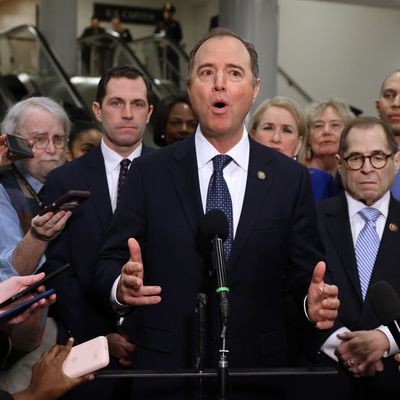
Day one of the Trump impeachment trial saw a fractious seesaw of contending arguments over a long series of Democratic amendments to Mitch McConnell’s “organizing resolution” to guide the proceeding. Day two of the trial was much smoother and more coherent. Under McConnell’s rules, House impeachment managers were given three days — Wednesday, Thursday, and Friday — to make their case for Trump’s removal, without interruption. Then Team Trump will get its three days, followed by a couple of days of responses to written senatorial questions to both sides, and then the all-important votes on the possibility of hearing witnesses and introducing additional evidence, the biggest point of contention (other than the final verdict itself) between Republicans and Democrats.
Lead impeachment manager Adam Schiff, who is developing something of a cult of love and hate for his eloquent and often defiant presentation of the case for impeachment and removal, led off with an overview of the three-day presentation. He indicated that the first day would be devoted to outlining the “scheme” whereby Trump abused his powers to pressure Ukraine to help him “cheat” in the 2020 elections by securing negative publicity for rival Joe Biden, and then used the same haughty powers to hide his misconduct via obstruction of Congress. The second day will focus on the constitutional requirements for impeachment and removal. And the last day will show how Trump’s behavior meets that constitutional standard and merits his removal. Schiff also made it clear that throughout the House presentation the case will be made for hearing witnesses and obtaining key documents:
During our presentation, you will see documentary records — those the President was unable to suppress — that expose the President’s scheme in detail. You will learn of further evidence that has been revealed in the days since the House voted to impeach President Trump, even as the President and his agents have persisted in their efforts to cover up their wrongdoing from Congress and the public.
And you will see dozens of new documents, providing new and critical evidence of the President’s guilt that remain in his hands, and in the hands of the Department of Defense and State, the Office of Management and Budget, even the White House. You will see them, and so will the public, if you will allow it. If, in the name of a fair trial, you will demand it.
Additional impeachment mangers alternated with Schiff in filling out evidence of the president’s quid pro quo “scheme.” Val Demings talked about the key meeting the White House held out to Ukrainian President Zelensky that he wanted so badly; Jason Crow discussed the stalled and desperately needed U.S. military assistance; and Hakeem Jeffries addressed Trump’s “perfect call” with Zelensky in detail. All of them naturally relied on the evidence Schiff’s Intelligence Committee collected in classified depositions and public testimony.
After a dinner break, Schiff stepped to the podium again, batting clean-up, as the Washington Post observed:
Schiff took over the chronology after the July 25 call, detailing the communications and activities that occurred around Ukraine’s efforts to get President Volodymyr Zelensky a White House visit by negotiating with Trump’s lawyer Rudolph W. Giuliani.
“Why would you go outside the normal channels to do that?” Schiff asked. “When your objective has nothing to do with policy, when your objective is a corrupt one . . . an illicit one. It means an impermissible one. It means one that furthers your own interests at the cost of the national interest.”
Zoe Lofgren closed the loop by bringing the narrative up through the whistle-blower report, congressional inquiries, and the ultimate release of Ukraine aid once the president had been “caught.”
As the impeachment managers worked their way through the House’s case, the chamber may have been (more or less) silent, but a lot was going on in the background.
Even though the president was overseas in Davos, he broke a personal record for volume of tweets, posting 131 by 4:45 p.m. And he tossed what Politico described as an “unwanted surprise” to the Republicans trying to save his presidency in Washington:
After Trump’s legal team emphatically supported McConnell’s organizing resolution setting up a potentially speedy trial, the president mused in Davos on Wednesday morning about going the “long way” on his trial, with testimony from a “a lot of people,” including former national security adviser John Bolton, Secretary of State Mike Pompeo, and former Energy Secretary Rick Perry.
But while this latest twist in Trump’s rhetoric is causing Republicans some heartburn, Democrats aren’t buying it just yet:
[W]hen they hear the president talk about encouraging Pompeo and Perry to testify, Democrats “don’t believe a word of it,” said Senate Minority Whip Dick Durbin (D-Ill.).
“He waits and sees if there’s a negative public reaction to his position, he announces he’s going to go the other way. And never does,” Durbin said.
On another front, Democrats beat back reports that they were interested in offering Republicans a deal whereby allowing John Bolton to testify might be “swapped” for an appearance by Hunter or Joe Biden. Biden himself stepped on the idea as one that would turn the trial into a “farce or political theater.”
We’re still probably a week or more from the moment of truth on the witness issue, but additional maneuvering will probably go on in the background as everyone tries to figure out if four Republican senators might defect and open up the trial. The other big question is whether either team’s laborious recapitulation of their positions on impeachment and removal will move public opinion, which is ultimately the ball game.






























